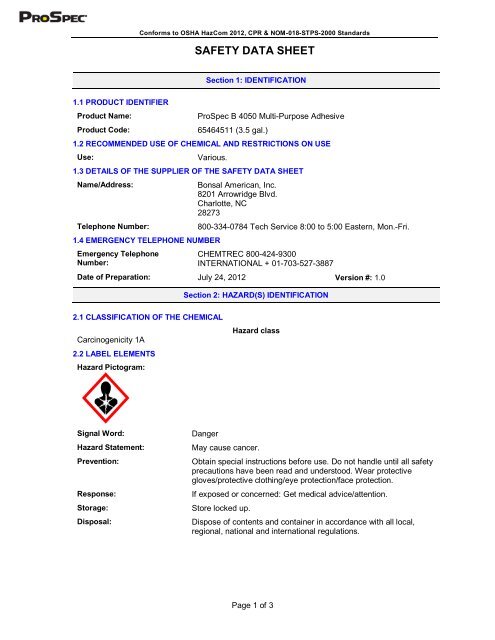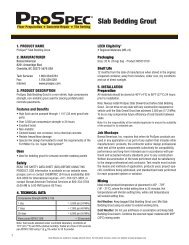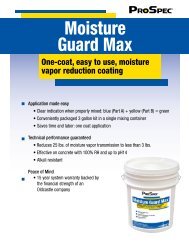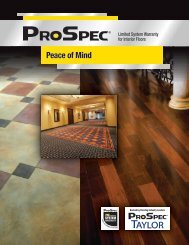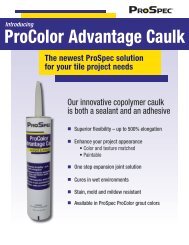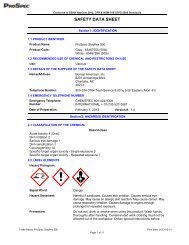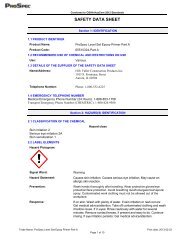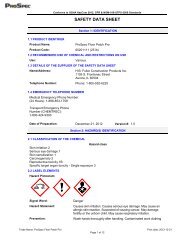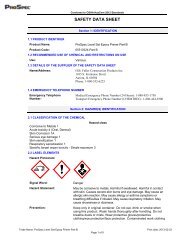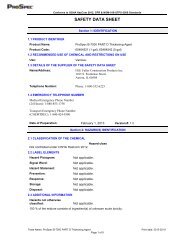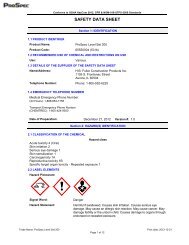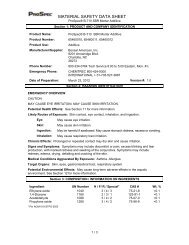B-4050 Multi-Purpose Tile Adhesive - Prospec
B-4050 Multi-Purpose Tile Adhesive - Prospec
B-4050 Multi-Purpose Tile Adhesive - Prospec
Create successful ePaper yourself
Turn your PDF publications into a flip-book with our unique Google optimized e-Paper software.
Conforms to OSHA HazCom 2012, CPR & NOM-018-STPS-2000 Standards<br />
SAFETY DATA SHEET<br />
Section 1: IDENTIFICATION<br />
1.1 PRODUCT IDENTIFIER<br />
Product Name:<br />
Product Code:<br />
ProSpec B <strong>4050</strong> <strong>Multi</strong>-<strong>Purpose</strong> <strong>Adhesive</strong><br />
65464511 (3.5 gal.)<br />
1.2 RECOMMENDED USE OF CHEMICAL AND RESTRICTIONS ON USE<br />
Use:<br />
Various.<br />
1.3 DETAILS OF THE SUPPLIER OF THE SAFETY DATA SHEET<br />
Name/Address:<br />
Telephone Number:<br />
1.4 EMERGENCY TELEPHONE NUMBER<br />
Emergency Telephone<br />
Number:<br />
Bonsal American, Inc.<br />
8201 Arrowridge Blvd.<br />
Charlotte, NC<br />
28273<br />
800-334-0784 Tech Service 8:00 to 5:00 Eastern, Mon.-Fri.<br />
CHEMTREC 800-424-9300<br />
INTERNATIONAL + 01-703-527-3887<br />
Date of Preparation: July 24, 2012 Version #: 1.0<br />
Section 2: HAZARD(S) IDENTIFICATION<br />
2.1 CLASSIFICATION OF THE CHEMICAL<br />
Carcinogenicity 1A<br />
2.2 LABEL ELEMENTS<br />
Hazard Pictogram:<br />
Hazard class<br />
Signal Word:<br />
Hazard Statement:<br />
Prevention:<br />
Response:<br />
Storage:<br />
Disposal:<br />
Danger<br />
May cause cancer.<br />
Obtain special instructions before use. Do not handle until all safety<br />
precautions have been read and understood. Wear protective<br />
gloves/protective clothing/eye protection/face protection.<br />
If exposed or concerned: Get medical advice/attention.<br />
Store locked up.<br />
Dispose of contents and container in accordance with all local,<br />
regional, national and international regulations.<br />
Page 1 of 3
Conforms to OSHA HazCom 2012, CPR & NOM-018-STPS-2000 Standards<br />
SAFETY DATA SHEET<br />
2.3 ADDITIONAL INFORMATION<br />
Hazards not otherwise<br />
classified:<br />
Not applicable.<br />
29 % of the mixture consists of ingredient(s) of unknown acute toxicity.<br />
This product is a hazardous chemical as defined by NOM-018-STPS-2000.<br />
Section 3: COMPOSITION/INFORMATION ON INGREDIENTS<br />
3.1 MIXTURES<br />
Ingredient UN # H / F/ R / * CAS No Wt. %<br />
Silica, crystalline, quartz Not available. Not available. 14808-60-7 0.1 - 1<br />
Formaldehyde 3077 3/2/0 50-00-0
Conforms to OSHA HazCom 2012, CPR & NOM-018-STPS-2000 Standards<br />
SAFETY DATA SHEET<br />
Specific Treatments:<br />
In case of accident or if you feel unwell, seek medical advice<br />
immediately (show the label or SDS where possible).<br />
Section 5: FIRE-FIGHTING MEASURES<br />
5.1 FLAMMABILITY<br />
Flammability:<br />
5.2 EXTINGUISHING MEDIA<br />
Suitable Extinguishing Media:<br />
Unsuitable Extinguishing Media:<br />
Not flammable by OSHA/WHMIS criteria.<br />
Treat for surrounding material.<br />
None known.<br />
5.3 SPECIAL HAZARDS ARISING FROM THE CHEMICAL<br />
Products of Combustion:<br />
Explosion Data:<br />
May include, and are not limited to: oxides of carbon.<br />
Sensitivity to Mechanical Impact: Not available.<br />
Sensitivity to Static Discharge: Not available.<br />
5.4 SPECIAL PROTECTIVE EQUIPMENT AND PRECAUTIONS FOR FIRE FIGHTERS<br />
Keep upwind of fire. Wear full fire fighting turn-out gear (full Bunker gear) and respiratory protection<br />
(SCBA).<br />
Section 6: ACCIDENTAL RELEASE MEASURES<br />
6.1 PERSONAL PRECAUTIONS, PROTECTIVE EQUIPMENT AND EMERGENCY PROCEDURES<br />
Use personal protection recommended in Section 8. Isolate the hazard area and deny entry to<br />
unnecessary and unprotected personnel.<br />
6.2 METHODS AND MATERIALS FOR CONTAINMENT AND CLEANING - UP<br />
Methods for Containment:<br />
Methods for Cleaning-Up:<br />
Contain spill, then place in a suitable container. Do not flush to<br />
sewer or allow to enter waterways. Use appropriate Personal<br />
Protective Equipment (PPE).<br />
Vacuum or sweep material and place in a disposal container.<br />
Section 7: HANDLING AND STORAGE<br />
7.1 PRECAUTIONS FOR SAFE HANDLING<br />
Handling:<br />
General Hygiene Advice:<br />
Avoid contact with skin and eyes. Do not swallow. Good housekeeping<br />
is important to prevent accumulation of dust. Avoid generating and<br />
breathing dust. Handle and open container with care. When using do<br />
not eat, drink or smoke. Do not swallow. (See section 8)<br />
Launder contaminated clothing before reuse. Wash hands before<br />
eating, drinking, or smoking.<br />
7.2 CONDITIONS FOR SAFE STORAGE, INCLUDING ANY INCOMPATIBILITIES<br />
Storage:<br />
Keep out of the reach of children. Keep container tightly closed and<br />
in a well-ventilated place. (See section 10)<br />
Page 3 of 3
Conforms to OSHA HazCom 2012, CPR & NOM-018-STPS-2000 Standards<br />
SAFETY DATA SHEET<br />
Section 8: EXPOSURE CONTROLS/PERSONAL PROTECTION<br />
8.1 CONTROL PARAMETERS<br />
Exposure Guidelines<br />
Occupational Exposure Limits<br />
Ingredient OSHA-PEL ACGIH-TLV<br />
Silica, crystalline, quartz<br />
((10 mg/m 3 )/(%SiO 2 +2) TWA (resp))<br />
((30 mg/m 3 )/(%SiO 2 +2) TWA (total))<br />
((250)/(%SiO 2 +5) mppcf TWA (resp)) 0.025 mg/m³<br />
Formaldehyde 0.75 ppm 0.3 ppm<br />
Ethyl acrylate 5 ppm 5 ppm<br />
Methyl alcohol 200 ppm 200 ppm<br />
8.2 EXPOSURE CONTROLS<br />
Engineering Controls:<br />
8.3 INDIVIDUAL PROTECTIVE MEASSURES<br />
Personal Protective Equipment:<br />
Eye/Face Protection:<br />
Skin Protection:<br />
Hand Protection:<br />
Body Protection:<br />
Respiratory Protection:<br />
General Health and Safety<br />
Measures:<br />
Use ventilation adequate to keep exposures (airborne levels of dust,<br />
fume, vapor, etc.) below recommended exposure limits.<br />
Wear eye/face protection.<br />
Wear suitable gloves.<br />
Wear suitable protective clothing.<br />
In case of insufficient ventilation, wear suitable respiratory equipment.<br />
Do not eat, smoke or drink where material is handled, processed or<br />
stored. Wash hands carefully before eating or smoking.<br />
Section 9: PHYSICAL AND CHEMICAL PROPERTIES<br />
9.1 INFORMATION ON BASIC PHYSICAL AND CHEMICAL PROPERTIES<br />
Appearance:<br />
Mastic.<br />
Color:<br />
Not available.<br />
Odor:<br />
Not available.<br />
Odor Threshold:<br />
Not available.<br />
Physical State:<br />
Solid.<br />
pH: 8.5<br />
Melting Point/Freezing Point:<br />
Not available.<br />
Initial Boiling Point and Boiling Range: Not available.<br />
Flash Point:<br />
Not available.<br />
Evaporation Rate:<br />
Not available.<br />
Flammability:<br />
Not Flammable.<br />
Lower Flammability/Explosive Limit: Not available.<br />
Page 4 of 3
Conforms to OSHA HazCom 2012, CPR & NOM-018-STPS-2000 Standards<br />
SAFETY DATA SHEET<br />
Upper Flammability/Explosive Limit: Not available.<br />
Vapor Pressure:<br />
Not available.<br />
Vapor Density:<br />
Not available.<br />
Relative Density/Specific Gravity: Not available.<br />
Solubility:<br />
Not available.<br />
Partition coefficient: n-octanol/water: Not available.<br />
Auto-ignition Temperature:<br />
Not available.<br />
Decomposition Temperature:<br />
Not available.<br />
Viscosity:<br />
Not available.<br />
Percent Volatile, wt. %:<br />
Not available.<br />
VOC content, wt. %: 0.00<br />
Section 10: STABILITY AND REACTIVITY<br />
10.1 REACTIVITY<br />
No dangerous reaction known under conditions of normal use.<br />
10.2 CHEMICAL STABILITY<br />
Stable under normal storage conditions.<br />
10.3 POSSIBILITY OF HAZARDOUS REACTIONS<br />
No dangerous reaction known under conditions of normal use.<br />
10.4 CONDITIONS TO AVOID<br />
Heat. Incompatible materials.<br />
10.5 INCOMPATIBLE MATERIALS<br />
None known.<br />
10.6 HAZARDOUS DECOMPOSITION PRODUCTS<br />
May include, and are not limited to: oxides of carbon.<br />
Section 11: TOXICOLOGICAL INFORMATION<br />
11.1 INFORMATION ON TOXICOLOGICAL EFFECTS<br />
Likely Routes of Exposure:<br />
Skin contact, eye contact, inhalation, and ingestion.<br />
Symptoms related to physical/chemical/toxicological characteristics:<br />
Eye:<br />
Skin:<br />
Ingestion:<br />
Inhalation:<br />
May cause eye irritation. Symptoms may include discomfort or pain,<br />
excess blinking and tear production, with marked redness and swelling of<br />
the conjunctiva.<br />
May cause skin irritation. Symptoms may include redness, edema, drying,<br />
defatting and cracking of the skin.<br />
May be harmful if swallowed. May cause stomach distress, nausea or<br />
vomiting.<br />
May cause respiratory tract irritation.<br />
Page 5 of 3
Conforms to OSHA HazCom 2012, CPR & NOM-018-STPS-2000 Standards<br />
SAFETY DATA SHEET<br />
Acute Toxicity:<br />
Ingredient IDLH LD50 LC50<br />
Ca [25 mg/m 3<br />
(cristobalite, tridymite)<br />
Silica, crystalline,<br />
quartz<br />
50 mg/m 3 (quartz,<br />
tripoli)] Oral Rat 500 mg/kg Not available.<br />
Formaldehyde Ca [20 ppm] Oral Rat 500 mg/kg Inhalation Rat 0.578 mg/L 4 h<br />
Ethyl acrylate Ca [300 ppm]<br />
Oral Rat 800 mg/kg<br />
Dermal Rabbit 500 µL/kg Inhalation Rat 1414 ppm 4 h<br />
Methyl alcohol 6000 ppm<br />
Oral Rat 5628 mg/kg<br />
Dermal Rabbit 15800 mg/kg<br />
Inhalation Rat 83.2 mg/L 4 h<br />
Inhalation Rat 64000 ppm 4 h<br />
Ingredient<br />
Calculated overall Chemical Acute Toxicity Values<br />
LC50 (inhalation) LD50 (oral) LD50 (dermal)<br />
Not available. 5524.1 mg/kg, rat Not available.<br />
Silica, crystalline, quartz<br />
Formaldehyde<br />
Ethyl acrylate<br />
Methyl alcohol<br />
Chemical Listed as Carcinogen or<br />
Potential Carcinogen<br />
(NTP, IARC, OSHA, ACGIH, CP65)*<br />
G-A2, I-1, N-1, CP65<br />
O, G-A2, I-1, N-2, CP65<br />
G-A4, I-2B, CP65<br />
CP65<br />
11.2 DELAYED, IMMEDIATE, AND CHRONIC EFFECTS OF SHORT- AND LONG-TERM EXPOSURE<br />
Skin Corrosion/Irritation:<br />
Serious Eye Damage/Irritation:<br />
Respiratory Sensitization:<br />
Skin Sensitization:<br />
STOT-Single Exposure:<br />
Chronic Health Effects:<br />
Carcinogenicity:<br />
Germ Cell Mutagenicity:<br />
Reproductive Toxicity:<br />
STOT-Repeated Exposure:<br />
Aspiration Hazard:<br />
Based on available data, the classification criteria are not met.<br />
Based on available data, the classification criteria are not met.<br />
Based on available data, the classification criteria are not met.<br />
Based on available data, the classification criteria are not met.<br />
Based on consideration of the components, and the measured<br />
viscosity, this product is not expected to cause any specific<br />
target organ effects, including lungs.<br />
Prolonged or repeated contact may dry skin and cause irritation.<br />
May cause cancer.<br />
This product is not classified as a mutagen.<br />
Developmental: This product does not contain known reproductive or<br />
developmental toxins.<br />
Teratogenicity: Not hazardous by WHMIS/OSHA criteria.<br />
Embryotoxicity:<br />
Fertility:<br />
Not hazardous by WHMIS/OSHA criteria.<br />
No known significant effects or critical hazards.<br />
Based on consideration of the components, this product is not<br />
expected to cause any specific target organ effects.<br />
Not expected to occur.<br />
Page 6 of 3
Conforms to OSHA HazCom 2012, CPR & NOM-018-STPS-2000 Standards<br />
SAFETY DATA SHEET<br />
Toxicologically Synergistic<br />
Materials:<br />
Other Information:<br />
Not available.<br />
Not available.<br />
Section 12: ECOLOGICAL INFORMATION<br />
12.1 ECOTOXICITY<br />
Acute/Chronic Toxicity: May cause long-term adverse effects in the aquatic environment.<br />
12.2 PERSISTENCE AND DEGRADABILITY<br />
Not available.<br />
12.3 BIOACCUMULATIVE POTENTIAL<br />
Bioaccumulation:<br />
Not available.<br />
12.4 MOBILITY IN SOIL<br />
Not available.<br />
12.5 OTHER ADVERSE EFFECTS<br />
Not available.<br />
Section 13: DISPOSAL CONSIDERATIONS<br />
13.1 WASTE TREATMENT METHODS<br />
Disposal Method:<br />
Other disposal recommendations:<br />
This material must be disposed of in accordance with all<br />
local, state, provincial, and federal regulations.<br />
Not available.<br />
Section 14: TRANSPORT INFORMATION<br />
14.1 UN NUMBER<br />
DOT TDG NOM-004-SCT2-1994<br />
Not regulated. Not regulated. Not regulated.<br />
14.2 UN PROPER SHIPPING NAME<br />
DOT TDG NOM-004-SCT2-1994<br />
Not applicable. Not applicable. Not applicable.<br />
14.3 TRANSPORT HAZARD CLASS (ES)<br />
DOT TDG NOM-004-SCT2-1994<br />
Not applicable. Not applicable. Not applicable.<br />
14.4 PACKING GROUP<br />
DOT TDG NOM-004-SCT2-1994<br />
Not applicable. Not applicable. Not applicable.<br />
14.5 ENVIRONMENTAL HAZARDS<br />
Not available.<br />
Page 7 of 3
Conforms to OSHA HazCom 2012, CPR & NOM-018-STPS-2000 Standards<br />
SAFETY DATA SHEET<br />
14.6 TRANSPORT IN BULK ACCORDING TO ANNEX II OF MARPOL 73/78 AND THE IBC CODE<br />
Not available.<br />
14.7 SPECIAL PRECAUTIONS FOR USER<br />
Do not handle until all safety precautions have been read and understood.<br />
Section 15: REGULATORY INFORMATION<br />
15.1 SAFETY, HEALTH AND ENVIRONMENTAL REGULATIONS/ LEGISLATIONS SPECIFIC FOR THE<br />
CHEMICLA<br />
Canadian: This product has been classified in accordance with the hazard criteria of the<br />
Controlled Products Regulations and the MSDS contains all the information required by the<br />
Controlled Products Regulations.<br />
US: MSDS prepared pursuant to the Hazard Communication Standard (CFR29 1910.1200) HazCom<br />
2012<br />
Mexico: MSDS prepared pursuant to NOM-018-STPS-2000.<br />
Ingredient<br />
SARA Title III<br />
Section 302 (EHS)<br />
TPQ (lbs.)<br />
Section 304<br />
EHS RQ (lbs.)<br />
CERCLA<br />
RQ (lbs.) Section 313<br />
Silica, crystalline, quartz Not listed. Not listed. Not listed. Not listed.<br />
Formaldehyde 500 100 100 313<br />
Ethyl acrylate Not listed. Not listed. 1,000 313<br />
Methyl alcohol Not listed. Not listed. 5,000 313<br />
California Proposition 65:<br />
State Regulations<br />
This product contains Crystalline Silica, Quartz and may also contain trace amounts of other chemicals<br />
known to the State of California to cause cancer, birth defects or other reproductive harm.<br />
Global Inventories:<br />
Ingredient<br />
Canada<br />
DSL/NDSL<br />
USA<br />
TSCA<br />
Silica, crystalline, quartz DSL Yes.<br />
Formaldehyde DSL Yes.<br />
Ethyl acrylate DSL Yes.<br />
Methyl alcohol DSL Yes.<br />
NFPA-National Fire Protection Association:<br />
Health: 1<br />
Fire: 1<br />
Reactivity: 0<br />
HMIS-Hazardous Materials Identification System:<br />
Health: 1*<br />
Fire: 1<br />
Reactivity: 0<br />
Hazard Rating: 0 = minimal, 1 = slight, 2 = moderate, 3 = severe, 4 = extreme<br />
Page 8 of 3
Conforms to OSHA HazCom 2012, CPR & NOM-018-STPS-2000 Standards<br />
SAFETY DATA SHEET<br />
WHMIS Classification(s):<br />
Class D2A - Carcinogenicity<br />
Class D2A - Chronic Toxic Effects<br />
WHMIS Hazard Symbols:<br />
Mexico Classification:<br />
Blue = Health Red = Flammability Yellow = Reactivity White = Special<br />
Hazard Rating: 0 = minimal, 1 = slight, 2 = moderate, 3 = severe, 4 = extreme<br />
SOURCE AGENCY CARCINOGEN CLASSIFICATIONS:<br />
CP65 California Proposition 65<br />
OSHA (O)<br />
ACGIH (G)<br />
IARC (I)<br />
NTP (N)<br />
Occupational Safety and Health Administration.<br />
American Conference of Governmental Industrial Hygienists.<br />
A1 - Confirmed human carcinogen.<br />
A2 - Suspected human carcinogen.<br />
A3 - Animal carcinogen.<br />
A4 - Not classifiable as a human carcinogen.<br />
A5 - Not suspected as a human carcinogen.<br />
International Agency for Research on Cancer.<br />
1 - The agent (mixture) is carcinogenic to humans.<br />
2A - The agent (mixture) is probably carcinogenic to humans; there is limited evidence of carcinogenicity in<br />
humans and sufficient evidence of carcinogenicity in experimental animals.<br />
2B - The agent (mixture) is possibly carcinogenic to humans; there is limited evidence of carcinogenicity in<br />
humans in the absence of sufficient evidence of carcinogenicity in experimental animals.<br />
3 - The agent (mixture, exposure circumstance) is not classifiable as to its carcinogenicity to humans.<br />
4 - The agent (mixture, exposure circumstance) is probably not carcinogenic to humans.<br />
National Toxicology Program.<br />
1 - Known to be carcinogens.<br />
2 - Reasonably anticipated to be carcinogens.<br />
Section 16: OTHER INFORMATION<br />
Date of Preparation: July 24, 2012<br />
Expiry Date: July 24, 2015<br />
Version: 1.0<br />
Revision Date: July 24, 2012<br />
Page 9 of 3
Conforms to OSHA HazCom 2012, CPR & NOM-018-STPS-2000 Standards<br />
SAFETY DATA SHEET<br />
Disclaimer: We believe the statements, technical information and recommendations contained herein<br />
are reliable, but they are given without warranty or guarantee of any kind. The information contained in<br />
this document applies to this specific material as supplied. It may not be valid for this material if it is used<br />
in combination with any other materials. It is the user’s responsibility to satisfy oneself as to the suitability<br />
and completeness of this information for the user’s own particular use.<br />
Prepared by:<br />
Prepared for:<br />
Nexreg Compliance Inc.<br />
Phone: (519) 488-5126<br />
www.nexreg.com<br />
Bonsal American, Inc.<br />
End of Safety Data Sheet<br />
Page 10 of 3


